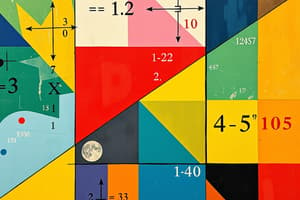Podcast
Questions and Answers
What is the definition of a coordinate plane?
What is the definition of a coordinate plane?
- A plane in which a horizontal number line and a vertical number line intersect at their zero points. (correct)
- A plane where a horizontal number line and a vertical number line do not intersect.
- A two-dimensional space with no defined axes.
- A system that uses only vertical lines.
What are equivalent ratios?
What are equivalent ratios?
Ratios that express the same relationship between two quantities.
What does it mean to graph a point?
What does it mean to graph a point?
To place a dot at a point named by an ordered pair.
What is the greatest common factor?
What is the greatest common factor?
What is the least common multiple?
What is the least common multiple?
What is an ordered pair?
What is an ordered pair?
What is the origin in a coordinate plane?
What is the origin in a coordinate plane?
What is prime factorization?
What is prime factorization?
What is a rate?
What is a rate?
What is a ratio?
What is a ratio?
What is a ratio table?
What is a ratio table?
What does scaling mean?
What does scaling mean?
What is the unit price?
What is the unit price?
What is a unit rate?
What is a unit rate?
What is the x-axis?
What is the x-axis?
What is the x-coordinate?
What is the x-coordinate?
What is the y-axis?
What is the y-axis?
What is the y-coordinate?
What is the y-coordinate?
Flashcards are hidden until you start studying
Study Notes
Definitions and Concepts
-
Coordinate Plane: A two-dimensional plane formed by the intersection of a horizontal (x-axis) and vertical (y-axis) number line at their zero points.
-
Equivalent Ratio: Ratios that represent the same relationship between two quantities, allowing different numerical expressions to convey the same proportion.
-
Graph: The action of plotting a point at a specific location defined by an ordered pair on the coordinate plane.
-
Greatest Common Factor (GCF): The largest factor shared by two or more numbers, simplifying common ratios.
-
Least Common Multiple (LCM): The smallest whole number greater than zero that is a common multiple among two or more numbers.
-
Ordered Pair: A set of two numbers used to define a specific location on the coordinate plane, typically formatted as (x-coordinate, y-coordinate).
-
Origin: The point where the x-axis and y-axis intersect, designated as (0, 0) on the coordinate plane.
-
Prime Factorization: A method of breaking down a composite number into a product of its prime factors, ensuring every factor is prime.
-
Rate: A specialized ratio comparing two quantities of different units, such as speed (miles per hour).
-
Ratio: A comparison of two quantities through division, expressed in several formats including fractions, decimals, or fraction-like structures (e.g., 2:3, 2/3).
-
Ratio Table: A structured table consisting of rows and columns representing pairings of numbers that maintain the same ratio throughout.
-
Scaling: The process of increasing or decreasing two related quantities by the same factor, preserving the original ratio.
-
Unit Price: The cost associated with a single unit of measurement, helpful for comparing costs in various contexts.
-
Unit Rate: A streamlined version of a rate where the second quantity is reduced to one unit, facilitating easy comparison (e.g., miles per hour as 60 mph).
-
X-Axis: The horizontal line on the coordinate plane, usually representing the independent variable in a graph.
-
X-Coordinate: The first number in an ordered pair that indicates the horizontal position of a point on the coordinate plane.
-
Y-Axis: The vertical line in the coordinate plane, typically used to represent the dependent variable in a graph.
-
Y-Coordinate: The second number in an ordered pair that indicates the vertical position of a point on the coordinate plane.
Studying That Suits You
Use AI to generate personalized quizzes and flashcards to suit your learning preferences.




